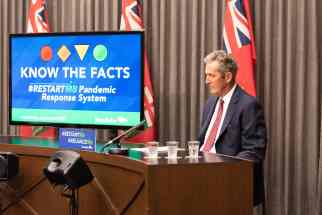Colour-coded alert system working exactly as it should
Read this article for free:
or
Already have an account? Log in here »
To continue reading, please subscribe:
Monthly Digital Subscription
$0 for the first 4 weeks*
- Enjoy unlimited reading on winnipegfreepress.com
- Read the E-Edition, our digital replica newspaper
- Access News Break, our award-winning app
- Play interactive puzzles
*No charge for 4 weeks then price increases to the regular rate of $19.00 plus GST every four weeks. Offer available to new and qualified returning subscribers only. Cancel any time.
Monthly Digital Subscription
$4.75/week*
- Enjoy unlimited reading on winnipegfreepress.com
- Read the E-Edition, our digital replica newspaper
- Access News Break, our award-winning app
- Play interactive puzzles
*Billed as $19 plus GST every four weeks. Cancel any time.
To continue reading, please subscribe:
Add Free Press access to your Brandon Sun subscription for only an additional
$1 for the first 4 weeks*
*Your next subscription payment will increase by $1.00 and you will be charged $16.99 plus GST for four weeks. After four weeks, your payment will increase to $23.99 plus GST every four weeks.
Read unlimited articles for free today:
or
Already have an account? Log in here »
Hey there, time traveller!
This article was published 25/08/2020 (1937 days ago), so information in it may no longer be current.
Manitoba may be seeing an uptick in COVID-19 cases in certain parts of the province, but the new pandemic response system is working the way it’s supposed to.
Cases of COVID-19 have been on the rise in the Brandon area and in several Hutterite colonies across the province. However, case numbers are only one of many indicators public health officials consider when altering measures to contain the spread of the disease.
What’s different about the #RestartMB Pandemic Response System (the colour-coded alert system unveiled by the province last week), is the measures taken are aimed specifically at hot-spot areas. Instead of making provincewide changes to public health orders — which some critics, including opposition politicians, continue to call for — the measures are implemented where they’re required.
That’s important in ongoing efforts to balance the fight against the disease with the critical need to reopen the economy, including getting kids back to school and weaning people and businesses off government subsidies.
![]()
The alert system — comprised of four risk levels, each with their own range of responses — was put into action almost immediately after it was announced. The Prairie Mountain Health region, which includes Brandon, was elevated to orange last week (the second highest alert level) in response to a growing number of cases and an increase in positive tests that could not be linked to known clusters. Instead of focusing on overall case numbers for the province (which have little significance on their own), public health took a “surgical” approach by mandating mask use and reducing crowd limits in that region.
It’s exactly how the system is supposed to work. And it’s having the desired effect. Cases are being aggressively contact-traced, people are self-isolating where required and the rest of the province — including Winnipeg, which has relatively low case numbers — is carrying on under existing public health orders.
It’s a measured and well-thought out approach. It’s not designed to create panic or fear and it lets people know in certain regions what their risk level might be. It’s good public health policy.
What helped bolster the effectiveness of the new system was the quick deployment of mobile testing to Hutterite colonies last week. That allowed public health officials to better identify where the virus is and to take early steps to contain it.
Government edicts and public health strategies will not prevent the spread of this disease.
The implementation of the alert system hasn’t been without its hiccups. There was confusion when the orange level was announced last week regarding when the new measures would apply. It’s something public health will have to iron out before the next alert level change is announced.
There likely will be more “code oranges” announced, whether it’s for a region or a town. Case numbers and test positivity rates will ebb and flow and there will be enough community transmission in some areas (among other indicator changes) to trigger an orange alert. People will have to get used to that. It doesn’t mean the sky is falling. It means people have to step up their efforts to contain the spread of the virus in a calm and reasoned manner.
Government edicts and public health strategies will not prevent the spread of this disease. Public health orders are important. And heated debates about what measures should be in place and how they should be enforced will likely continue until this thing is over.
But in the end, it’s up to individuals to follow public health orders and recommendations and to use common sense. We can’t look to government to solve every aspect of this pandemic.
But in the end, it’s up to individuals to follow public health orders and recommendations and to use common sense. We can’t look to government to solve every aspect of this pandemic. Indeed, we’re already seeing some in the private and public sector take action on their own, including the mandatory use of masks in some places where it’s not mandated by the province.
Despite the increase in cases in some parts of the province, this virus is still largely under control in Manitoba. Dr. Brent Roussin, the province’s chief public health officer, continues to remind people to “get back to the basics,” including social distancing, staying home when you’re sick and washing your hands often. People should listen to him. His recommendations are well reasoned and based on the best available public health evidence. If they follow those recommendations, the pandemic in Manitoba will remain largely under control for the foreseeable future.
tom.brodbeck@freepress.mb.ca

Tom has been covering Manitoba politics since the early 1990s and joined the Winnipeg Free Press news team in 2019.
Our newsroom depends on a growing audience of readers to power our journalism. If you are not a paid reader, please consider becoming a subscriber.
Our newsroom depends on its audience of readers to power our journalism. Thank you for your support.
History
Updated on Wednesday, August 26, 2020 9:55 AM CDT: Fixes name of Dr. Brent Roussin.








